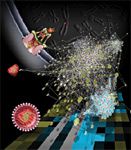Big Science
HIV infection unzips its genes
One robot: The Automated Lenti-Viral System, custom-built by Novartis engineers.
» 144,000 individually coded strands of short interfering RNA: Six or seven for each of the human genome's 20,000 genes
» 20,000 human immune cells and an equal number of copies of HIV, the human immunodeficiency virus, accessorized with Luciferase, a light-emitting reporter virus
» Vast electronic databases detailing thousands upon thousands of gene ontologies and protein interactions
This is a short list of materials used by researchers at the Salk Institute for Biological Studies, the Burnham Institute for Medical Research, and the Novartis Research Foundation's Genomics Institute to answer the question: When HIV infects a human immune cell, which of the cell's own genes play a role?
"This study brings together two powerful new technologies: genomics and proteomics," says Burnham's Sumit Chanda, a co-author of the study published in the journal Cell. "The results open a new front in the fight against HIV."
What merits such braggadocio? All but two of the two dozen or so HIV drugs on the market take aim at the virus itself. By doing a genetic shakedown of the immune cell as it is being infected, Chanda and his colleagues have served up a feast of host-cell targets—including 295 genes, 60 of which are high-value targets—with the potential to yield new classes of HIV drugs. "Quite a few are already known to be 'druggable' by small molecules," says Salk's John Young, a study co-author. "Those rise to the top of the list in terms of priority, and we expect Big Pharma to go after them once we validate them."
The cause of AIDS is, of course, already known—and the two French scientists who discovered HIV 25 years ago were honored with the Nobel Prize for Medicine the same week in October that this study hit. One big unknown—until now—was what Young refers to as "the flight pattern" the virus follows in its pursuit of the host cell's DNA treasure. "What's new is that we've mapped the HIV–host cell protein interactions," Chanda says. "This gives a spatial understanding of the dynamics of the two cells during infection." (See illustration.)

With only nine genes and 15 proteins of its own, HIV (bottom left) exploits 295 of the host cell's genes to do its dirty work, triggering several hundred protein interactions in the process. Many of these may be potential drug targets. Source: Dr. John Young, Salk Institute for Biological Studies
As significant the results and sophisticated the technology is, the actual experiment was QED: First, silence a gene in the immune cell using RNA interference, then introduce the HIV vector and wait a few days for the result. "When infection takes place, the cell glows," says Chanda, referring to Luciferase's firefly-colored light that is turned on when HIV has succeeded in hijacking the human DNA. Now repeat the experiment about 50,000 times, knocking down gene after gene after gene until the entire 20,000-gene human genome has been tested. Then repeat once (or twice) for good measure. (That's where the Novartis ALVS robot came in handy—the little guy worked nonstop for a year.) Finally, turning from test tubes to the computer, researchers combed through those massive databases to clarify the function each gene performed as well as to ID the several hundred protein interactions involved.
Chanda and Young are eager to start screening compounds, but drug discovery is a pricey proposition. "A patent application has been put together to cover this IP," Young says. With Novartis a patent holder, the company may be planning to bolster its lackluster HIV R&D. As for the gene-silencing approach, Alnylam, Sirna, and other biotechs are trying to solve the systemic delivery problem. "We hope our study will accelerate interest in targeting HIV," says Chanda, "But the field is a few years from knowing the possibilities and limitations of RNAi therapeutics."
And now there's a map to follow.
—Walter Armstrong
Addressing Disparities in Psoriasis Trials: Takeda's Strategies for Inclusivity in Clinical Research
April 14th 2025LaShell Robinson, Head of Global Feasibility and Trial Equity at Takeda, speaks about the company's strategies to engage patients in underrepresented populations in its phase III psoriasis trials.
Beyond the Prescription: Pharma's Role in Digital Health Conversations
April 1st 2025Join us for an insightful conversation with Jennifer Harakal, Head of Regulatory Affairs at Canopy Life Sciences, as we unpack the evolving intersection of social media and healthcare decisions. Discover how pharmaceutical companies can navigate regulatory challenges while meaningfully engaging with consumers in digital spaces. Jennifer shares expert strategies for responsible marketing, working with influencers, and creating educational content that bridges the gap between patients and healthcare providers. A must-listen for pharma marketers looking to build trust and compliance in today's social media landscape.
Pfizer, GSK Gain ACIP Recommendations for RSV and Meningococcal Vaccines
April 18th 2025The Centers for Disease Control and Prevention’s Advisory Committee on Immunization Practices voted to expand access to Pfizer’s respiratory syncytial virus vaccine Abrysvo for high-risk adults in their 50s and voted in favor of GSK’s meningococcal vaccine, Penmenvy, for streamlined adolescent protection.
